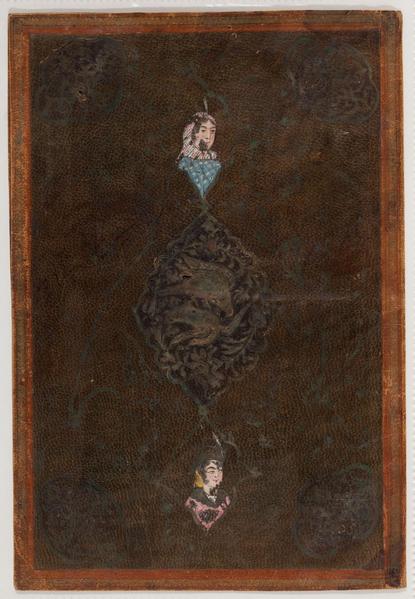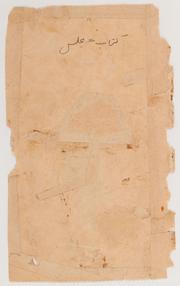File:Manṣūr’s Anatomy WDL9719.pdf

Original file (2,595 × 3,750 pixels, file size: 21.26 MB, MIME type: application/pdf, 56 pages)
Captions
Captions
Summary[edit]
| Author |
Русский: Ибн Ильяс, Мансур ибн Мухаммад, расцвет творчества в 1384 г.
Français : Ibn Ilyās, Manṣūr ibn Muḥammad, actif en 1384
English: Ibn Ilyās, Manṣūr ibn Muḥammad, flourished 1384
中文:曼苏尔·伊本·穆罕默德·伊本·伊里亚斯,全盛时期 1384 年
Português: Ibn Ilyās, Manṣūr ibn Muḥammad, prosperou em 1384
العربية: منصور بن محمد بن إلياس، ازدهرت أعماله في 1384
Español: Ibn Ilyās, Manṣūr ibn Muḥammad, prosperó en 1384 |
| Title |
Русский: Анатомия Мансура
Français : Anatomie de Manṣūr
English: Manṣūr’s Anatomy
中文:曼苏尔解剖学
Português: Anatomia de Manṣūr
العربية: تشريح منصوري
Español: Anatomía de Manṣūr |
| Description |
Русский: Персидский врач Мансур ибн Мухаммад ибн Ильяс, расцвет творчества которого приходится на около 1384 г., родился в семье врачей и других интеллектуалов из города Шираз в современном Иране. "Tashrīḥ-i badan-i insān" ("Анатомия человеческого тела"), обычно называемая "Tashrīḥ-i Manṣūrī" ("Анатомия Мансура"), представляет собой его наиболее известную работу. В ней содержатся самые ранние из дошедших до нас исламских анатомических иллюстраций человеческого тела. Они включают в себя фигуры на полную страницу, нарисованные пером и чернилами различных цветов. Трактат начинается с введения, за которым следуют главы о костях, нервах, мускулах, венах и артериях. Завершает текст глава о сложных органах, таких как сердце и мозг, и об образовании плода, включая рисунок, представляющий собой систему кровообращения беременной женщины. Работа посвящена султану по имени Пир Мухаммад ибн Умар ибн Тимур, правителю области Фарс в Персии около 1393–1409 гг. и правнуку Тимура, известного европейцам как Тамерлан. Эта рукопись была переписана в 1709 г. письмом насх среднего размера на коричневой бумаге верже с красными кустодами и заголовками. В рукописи просматривается определенное влияние индийского стиля. Рукопись была подарена Джоном Фаркухаром Фултоном и является частью коллекции редких книг Кушинга в Медицинской исторической библиотеке Медицинской библиотеки имени Харви Кушинга/Джона Хэй Уитни Йельского университета.
Анатомия человека; Медицина, арабская; Медицина, средневековая Français : Le médecin persan Manṣūr ibn Muḥammad ibn Ilyās, actif en 1384 environ, était issu d'une famille de médecins et d'intellectuels vivant dans la ville de Shiraz, dans l'actuel Iran. Tashrīḥ-i badan-i insān (L'anatomie du corps humain), généralement intitulé Tashrīḥ-i Manṣūrī (Anatomie de Manṣūr), est son œuvre la plus connue. Elle contient les illustrations les plus anciennes existant encore aujourd'hui de l'anatomie islamique de tout le corps humain. Celles-ci incluent des personnages de la taille d'une page, dessinés à la plume avec différentes couleurs d'encre. Le traité est composé d'une introduction, suivie de chapitres sur les os, les nerfs, les muscles, les veines et les artères. Il conclut par un chapitre sur les organes, tels que le cœur et le cerveau, et sur la formation du fœtus, comportant également un dessin du système artériel d'une femme enceinte. L'ouvrage est dédié à Sulṭān Pīr Muḥammad ibn 'Umar ibn Tīmūr, souverain de la région du Fars en Perse entre 1393 et 1409 environ, et petit-fils de Tamerlan. Copié en 1709, il fut réalisé en caractères naskhi de taille moyenne sur du papier vergé brun, avec des réclames et des titres à l'encre rouge. On y retrouve une certaine influence du style indien. Le manuscrit fut offert par John Farquhar Fulton et fait partie de la collection de livres rares de Cushing conservés à la bibliothèque d'histoire de la médecine située au cœur de la bibliothèque médicale Harvey Cushing/John Hay Whitney de l'Université de Yale.
Anatomie humaine; Médecine arabe; Médecine médiévale English: The Persian physician Manṣūr ibn Muḥammad ibn Ilyās, who flourished around 1384, came from a family of physicians and other intellectuals living in the city of Shiraz in present-day Iran. Tashrīḥ-i badan-i insān (The anatomy of the human body), usually known as Tashrīḥ-i Manṣūrī (Manṣūr’s anatomy), is his best-known work. It contains the earliest surviving Islamic anatomical illustrations of the whole human body. They include full-page figures, drawn in pen using various colors of ink. The treatise consists of an introduction followed by chapters on the bones, nerves, muscles, veins, and arteries. A concluding chapter is on compound organs, such as the heart and brain, and on the formation of the fetus, and includes a figure representing the arterial system of a pregnant woman. The work is dedicated to Sulṭān Pīr Muḥammad ibn ʻUmar ibn Tīmūr, ruler of the Fars region of Persia circa 1393–1409 and grandson of Timur, known to Europeans as Tamerlane. This manuscript was copied in 1709 in a medium-sized naskh script on brown laid paper with catchwords and headings in red. There is some Indian stylistic influence. The manuscript was a gift of John Farquhar Fulton and forms part of the Cushing collection of rare books at the Medical Historical Library in the Harvey Cushing/John Hay Whitney Medical Library, Yale University.
Human anatomy; Medicine, Arab; Medicine, Medieval 中文:曼苏尔·伊本·穆罕默德·伊本·伊里亚斯(Manṣūr ibn Muḥammad ibn Ilyās,全盛时期 1384 年左右)是一位波斯医生,出生于设拉子市(今伊朗境内)的一个医生和知识分子家庭。Tashrīḥ-i badan-i insān(《人体解剖学》通常被称为 Tashrīḥ-i Manṣūrī (《曼苏尔解剖学》),是他最著名的作品。书中包含现存最早的伊斯兰完整人体解剖图,其中附有使用不同颜色的墨水绘制的整页钢笔图。该著作以序言开篇,后面分别是阐释骨骼、神经、肌肉、静脉和动脉的章节。最后一章探讨了复合器官(如心脏和大脑)及胎儿的形成,并且附有一张展示孕妇动脉系统的图。这部作品专为苏丹皮尔·穆罕默德·伊本·奥马尔·伊本·帖木儿 (Pīr Muḥammad ibn ʻUmar ibn Tīmūr) 而作,他大约在 1393-1409 年是波斯法尔斯地区的统治者,也是帖木儿(欧洲人称为 Tamerlane)的孙子。这部手稿誊抄于 1709 年,以中等大小的纳斯赫体书写,使用棕色直纹纸,标字和标题采用了红色字体。其中有一些受到印度风格影响的痕迹。这份手稿是约翰·法夸尔·富尔顿 (John Farquhar Fulton) 赠送的礼物,也是耶鲁大学的医学历史图书馆中库欣珍贵藏书的一部分。医学历史图书馆是耶鲁大学哈维•库欣∕約翰•海•惠特尼医学图书馆的下属藏书馆。
人体解剖; 阿拉伯医学; 中世纪医学 Português: O médico persa Mansur ibn Muhammad ibn Ilyas, que prosperou por volta de 1384, veio de uma família de médicos e outros intelectuais que viviam na cidade de Shiraz, atual Irã. Tashrīḥ-i badan-i insān (A anatomia do corpo humano), normalmente conhecido como Tashrīḥ-i Manṣūrī (A anatomia de Manṣūr) é seu trabalho mais conhecido. Ele contém as primeiras ilustrações islâmicas restantes de todo o corpo humano. Elas incluem figuras em página cheia desenhadas com várias cores de tinta. O tratado é composto por uma introdução seguida por capítulos sobre ossos, nervos, músculos, veias e artérias. Um capítulo de conclusão trata de órgãos compostos, como o coração e o cérebro, e a formação do feto, além de incluir uma figura que representa o sistema arterial de uma mulher grávida. A obra é dedicada ao Sultão Pīr Muḥammad ibn ʻUmar ibn Tīmūr, governante da região de Fars da Pérsia por volta de 1393–1409 e neto de Timur, conhecido para os europeus como Tamerlão. Este manuscrito foi copiado em 1709 em escrita naskh de médio porte em papel marrom com as palavras de ordem e os cabeçalhos em vermelho. Há certa influência estilística indiana. O manuscrito foi um presente de John Farquhar Fulton e compõe parte da coleção Cushing de livros raros da Biblioteca Histórica Médica presente na Biblioteca Médica Harvey Cushing/John Hay Whitney, Universidade de Yale.
Anatomia humana; Medicina, árabe; Medicina, medieval العربية: ينحدر الطبيب الفارسي منصور بن محمد بن إلياس، الذي ازدهر حوالي عام 1384، من نسل طويل من الأطباء والمفكرين، كانوا يعيشون في مدينة شيراز، في إيران حالياً. ويُعد كتاب تشريح بدن إنسان والمعروف عادة بعنوان تشريح منصوري، أشهر أعماله. ويحتوي الكتاب على أول رسوم توضيحية تشريحية إسلامية باقية، توضّح جسم الإنسان بأكمله. وهي تشمل رسوم يشغل كل منها صفحة كاملة، مرسومة بالقلم باستخدام أحبار مختلفة الألوان. تتألف الدراسة من مقدمة يليها فصول عن العظام والأعصاب والعضلات والأوردة والشرايين. ويتناول الفصل الختامي الأعضاء المركبة، مثل القلب والمخ، بالإضافة إلى تكوين الجنين، ويتضمن رسماً يُصور الشَبَكة الشريانية للمرأة الحامل. تم إهداء هذا العمل للسلطان بير محمد بن عمرو بن تيمور، حاكم منطقة فارس في إيران حوالي 1393-1409 وحفيد تيمور، والمعروف في أوروبا باسم تَيْمورلِنك. تم نسخ هذه المخطوطة في 1709 بخط نسخ متوسط الحجم على ورق مضلّع بني اللون، مع كتابة العناوين والكلمات الهامة باللون الأحمر. تظهر بعض ملامح التأثر بالأسلوب الهندي.كانت المخطوطة هدية من جون فاركوهار فولتون وتُشكل جزءاً من مجموعة كاشينغ للكتب النادرة والموجودة بالمكتبة الطبية التاريخية ضمن مكتبة هارفي كاشينغ/جون هاي وِتْنِي بجامعة ييل.
أعضاء جسم الإنسان; الطب العربي; طب العصور الوسطى Español: El médico persa Manṣūr ibn Muḥammad ibn Ilyās, que prosperó alrededor de 1384, provenía de una familia de médicos y otros intelectuales que vivían en la ciudad de Shiraz, en el actual Irán. Tashrīḥ-i badan-i insān (La anatomía del cuerpo humano), que suele conocerse como Tashrīḥ-i Manṣūrī (La anatomía de Manṣūr) es su obra más famosa. Contiene las más antiguas ilustraciones islámicas anatómicas de todo cuerpo humano que sobreviven. Incluyen imágenes a toda página, dibujadas en tinta de varios colores. El tratado consta de una introducción seguida de capítulos sobre los huesos, los músculos, los nervios, las venas y las arterias. Un capítulo final trata sobre órganos complejos (como el corazón y el cerebro) y la formación del feto, e incluye una imagen que representa el sistema arterial de la mujer embarazada. La obra está dedicada al sultán Pīr Muḥammad ibn ʻUmar ibn Tīmūr, gobernante de la región de Fars de Persia, circa 1393-1409, y nieto de Timur, conocido por los europeos como Tamerlán. Este manuscrito fue copiado en 1709 en una escritura naskh mediana sobre papel marrón verjurado, y las palabras clave y los títulos están en rojo. Muestra un poco de influencia estilística de India. El manuscrito fue un regalo de John Farquhar Fulton y forma parte de la colección Cushing de libros raros de medicina de la Biblioteca de Historia de la Medicina, parte de la Biblioteca Harvey Cushing/John Hay Whitney, de la Universidad de Yale.
Anatomía humana; Medicina, árabe; Medicina, medieval |
| Date |
27 March 1709 date QS:P571,+1709-03-27T00:00:00Z/11 |
| Medium |
Русский: Рукописи
Français : Manuscrits
English: Manuscripts
中文:手稿
Português: Manuscritos
العربية: مخطوطات
Español: Manuscritos |
| Dimensions |
English: 35 folios ; 20.2 x 30 centimeters |
| Collection |
Русский: Библиотека Йельского университета
Français : Bibliothèque universitaire de Yale
English: Yale University Library
中文:耶鲁大学图书馆
Português: Biblioteca da Universidade de Yale
العربية: مكتبة جامعة ييل
Español: Biblioteca de la Universidad de Yale |
| Place of creation |
Русский: Иран, Исламская Республика
Français : Iran (République islamique d')
English: Iran, Islamic Republic of
中文:伊朗(伊斯兰共和国)
Português: Irã (República Islâmica do)
العربية: الجمهورية الإسلامية الإيرانية
Español: Irán, República Islámica de |
| Notes |
Original language title: تشريح منصوري Русский: Медицинская историческая библиотека: персидские рук. Кушингa 14.
Français : Bibliothèque d'histoire de la médecine : Cushing Persian Ms. 14.
English: Historical Medical Library: Cushing Persian Ms. 14.
中文:医学历史图书馆:库欣波斯文手稿 14.
Português: Biblioteca Médica Histórica: Cushing, Ms persa 14.
العربية: المكتبة الطبية التاريخية: كاشينغ، مخطوطة فارسية رقم 14
Español: Biblioteca de Historia de la Medicina: Cushing, Ms. persa 14 |
| Source/Photographer |
http://dl.wdl.org/9719/service/9719.pdf
|
Licensing[edit]
|
This is a faithful photographic reproduction of a two-dimensional, public domain work of art. The work of art itself is in the public domain for the following reason:
The official position taken by the Wikimedia Foundation is that "faithful reproductions of two-dimensional public domain works of art are public domain".
This photographic reproduction is therefore also considered to be in the public domain in the United States. In other jurisdictions, re-use of this content may be restricted; see Reuse of PD-Art photographs for details. | |||||
File history
Click on a date/time to view the file as it appeared at that time.
| Date/Time | Thumbnail | Dimensions | User | Comment | |
|---|---|---|---|---|---|
| current | 04:14, 15 March 2014 |  | 2,595 × 3,750, 56 pages (21.26 MB) | Fæ (talk | contribs) | =={{int:filedesc}}== {{Artwork |artist = |author ={{ru|1=Ибн Ильяс, Мансур ибн Мухаммад, расцвет творчества в 1384 г.}} {{fr|1=Ibn Ilyās, Manṣūr ibn Muḥammad, actif en 1384}} {{en|1=Ibn Ilyās, Manṣ... |
You cannot overwrite this file.
File usage on Commons
The following page uses this file:
Metadata
This file contains additional information such as Exif metadata which may have been added by the digital camera, scanner, or software program used to create or digitize it. If the file has been modified from its original state, some details such as the timestamp may not fully reflect those of the original file. The timestamp is only as accurate as the clock in the camera, and it may be completely wrong.
| Image title | This document was downloaded from the World Digital Library (http://www.wdl.org). Go to http://hdl.loc.gov/loc.wdl/wdl.9719 for more information about this item. |
|---|---|
| Keywords | This document was downloaded from the World Digital Library (http://www.wdl.org). Go to http://hdl.loc.gov/loc.wdl/wdl.9719 for more information about this item. |
| Conversion program | Mac OS X 10.6.8 Quartz PDFContext |
| Encrypted | no |
| Page size |
|
| Version of PDF format | 1.3 |
